Ethyl 7-nitro-1H-indole-2-carboxylate
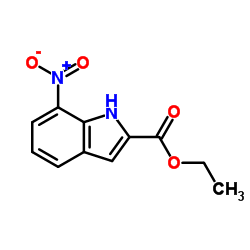
Ethyl 7-nitro-1H-indole-2-carboxylate structure
|
Common Name | Ethyl 7-nitro-1H-indole-2-carboxylate | ||
|---|---|---|---|---|
| CAS Number | 6960-46-9 | Molecular Weight | 234.208 | |
| Density | 1.4±0.1 g/cm3 | Boiling Point | 429.5±25.0 °C at 760 mmHg | |
| Molecular Formula | C11H10N2O4 | Melting Point | 90-96 °C | |
| MSDS | N/A | Flash Point | 213.5±23.2 °C | |
| Name | Ethyl 7-nitroindole-2-carboxylate |
|---|---|
| Synonym | More Synonyms |
| Density | 1.4±0.1 g/cm3 |
|---|---|
| Boiling Point | 429.5±25.0 °C at 760 mmHg |
| Melting Point | 90-96 °C |
| Molecular Formula | C11H10N2O4 |
| Molecular Weight | 234.208 |
| Flash Point | 213.5±23.2 °C |
| Exact Mass | 234.064056 |
| PSA | 87.91000 |
| LogP | 3.59 |
| Vapour Pressure | 0.0±1.0 mmHg at 25°C |
| Index of Refraction | 1.652 |
Synonym:None Section 2 - COMPOSITION, INFORMATION ON INGREDIENTS
Risk Phrases: None Listed. Section 3 - HAZARDS IDENTIFICATION EMERGENCY OVERVIEW
The toxicological properties of this material have not been fully investigated. Potential Health Effects Eye: May cause eye irritation. Skin: May cause skin irritation. Ingestion: May cause irritation of the digestive tract. The toxicological properties of this substance have not been fully investigated. Inhalation: May cause respiratory tract irritation. The toxicological properties of this substance have not been fully investigated. Chronic: No information found. Section 4 - FIRST AID MEASURES Eyes: Flush eyes with plenty of water for at least 15 minutes, occasionally lifting the upper and lower eyelids. Get medical aid immediately. Skin: Get medical aid. Flush skin with plenty of water for at least 15 minutes while removing contaminated clothing and shoes. Wash clothing before reuse. Ingestion: Never give anything by mouth to an unconscious person. Get medical aid. Do NOT induce vomiting. If conscious and alert, rinse mouth and drink 2-4 cupfuls of milk or water. Inhalation: Remove from exposure and move to fresh air immediately. If not breathing, give artificial respiration. If breathing is difficult, give oxygen. Get medical aid. Notes to Physician: Section 5 - FIRE FIGHTING MEASURES General Information: As in any fire, wear a self-contained breathing apparatus in pressure-demand, MSHA/NIOSH (approved or equivalent), and full protective gear. During a fire, irritating and highly toxic gases may be generated by thermal decomposition or combustion. Extinguishing Media: Use water spray, dry chemical, carbon dioxide, or appropriate foam. Section 6 - ACCIDENTAL RELEASE MEASURES General Information: Use proper personal protective equipment as indicated in Section 8. Spills/Leaks: Sweep up, then place into a suitable container for disposal. Avoid generating dusty conditions. Provide ventilation. Section 7 - HANDLING and STORAGE Handling: Wash thoroughly after handling. Remove contaminated clothing and wash before reuse. Use with adequate ventilation. Avoid contact with eyes, skin, and clothing. Avoid ingestion and inhalation. Storage: Store in a tightly closed container. Store in a cool, dry, well-ventilated area away from incompatible substances. Section 8 - EXPOSURE CONTROLS, PERSONAL PROTECTION Engineering Controls: Facilities storing or utilizing this material should be equipped with an eyewash facility and a safety shower. Use adequate ventilation to keep airborne concentrations low. Exposure Limits CAS# 6960-46-9: Personal Protective Equipment Eyes: Wear appropriate protective eyeglasses or chemical safety goggles as described by OSHA's eye and face protection regulations in 29 CFR 1910.133 or European Standard EN166. Skin: Wear appropriate protective gloves to prevent skin exposure. Clothing: Wear appropriate protective clothing to prevent skin exposure. Respirators: A respiratory protection program that meets OSHA's 29 CFR 1910.134 and ANSI Z88.2 requirements or European Standard EN 149 must be followed whenever workplace conditions warrant respirator use. Section 9 - PHYSICAL AND CHEMICAL PROPERTIES Physical State: Solid Color: pale yellow Odor: none reported pH: Not available. Vapor Pressure: Not available. Viscosity: Not available. Boiling Point: Not available. Freezing/Melting Point: 90.00 - 92.00 deg C Autoignition Temperature: Not applicable. Flash Point: Not applicable. Explosion Limits, lower: Not available. Explosion Limits, upper: Not available. Decomposition Temperature: Not available. Solubility in water: negligible Specific Gravity/Density: Not available. Molecular Formula: C11H10N2O4 Molecular Weight: 234.21 Section 10 - STABILITY AND REACTIVITY Chemical Stability: Stable under normal temperatures and pressures. Conditions to Avoid: Incompatible materials, strong oxidants. Incompatibilities with Other Materials: Oxidizing agents. Hazardous Decomposition Products: Irritating and toxic fumes and gases. Hazardous Polymerization: Has not been reported Section 11 - TOXICOLOGICAL INFORMATION RTECS#: CAS# 6960-46-9 unlisted. LD50/LC50: Not available. Carcinogenicity: Ethyl 7-nitroindole-2-carboxylate - Not listed by ACGIH, IARC, or NTP. Section 12 - ECOLOGICAL INFORMATION Section 13 - DISPOSAL CONSIDERATIONS Dispose of in a manner consistent with federal, state, and local regulations. Section 14 - TRANSPORT INFORMATION IATA Not regulated as a hazardous material. IMO Not regulated as a hazardous material. RID/ADR Not regulated as a hazardous material. Section 15 - REGULATORY INFORMATION European/International Regulations European Labeling in Accordance with EC Directives Hazard Symbols: Not available. Risk Phrases: Safety Phrases: S 24/25 Avoid contact with skin and eyes. WGK (Water Danger/Protection) CAS# 6960-46-9: No information available. Canada None of the chemicals in this product are listed on the DSL/NDSL list. CAS# 6960-46-9 is not listed on Canada's Ingredient Disclosure List. US FEDERAL TSCA CAS# 6960-46-9 is not listed on the TSCA inventory. It is for research and development use only. SECTION 16 - ADDITIONAL INFORMATION N/A |
|
~93% 
Ethyl 7-nitro-1... CAS#:6960-46-9 |
| Literature: Purzer Pharmaceutical Co., Ltd. Patent: EP2366687 A2, 2011 ; Location in patent: Page/Page column 8-10 ; |
|
~74% 
Ethyl 7-nitro-1... CAS#:6960-46-9 |
| Literature: Narayana; Ashalatha; Vijaya Raj; Fernandes; Sarojini Bioorganic and Medicinal Chemistry, 2005 , vol. 13, # 15 p. 4638 - 4644 |
|
~78% 
Ethyl 7-nitro-1... CAS#:6960-46-9 |
| Literature: Murakami; Watanabe; Yokoyama; Naomachi; Iwase; Morihata; Okuyama; Kamakura; Takahashi; Atoda; Tojo; Morita; Ishii Chemical and Pharmaceutical Bulletin, 1993 , vol. 41, # 11 p. 1910 - 1919 |
|
~78% 
Ethyl 7-nitro-1... CAS#:6960-46-9 |
| Literature: Sudhakara; Jayadevappa; Mahadevan; Hulikal, Vijaykumar Synthetic Communications, 2009 , vol. 39, # 14 p. 2506 - 2515 |
|
~% 
Ethyl 7-nitro-1... CAS#:6960-46-9 |
| Literature: Chemical and Pharmaceutical Bulletin, , vol. 41, # 11 p. 1910 - 1919 |
|
~% 
Ethyl 7-nitro-1... CAS#:6960-46-9 |
| Literature: Bioorganic and Medicinal Chemistry, , vol. 22, # 6 p. 1850 - 1862 |
| HS Code | 2933990090 |
|---|---|
| Summary | 2933990090. heterocyclic compounds with nitrogen hetero-atom(s) only. VAT:17.0%. Tax rebate rate:13.0%. . MFN tariff:6.5%. General tariff:20.0% |
| 1H-Indole-2-carboxylic acid, 7-nitro-, ethyl ester |
| Ethyl 7-nitro-1H-indole-2-carboxylate |
| MFCD00216475 |
| Indole-2-carboxylic acid, 7-nitro-, ethyl ester |
![ethyl 2-[2-(2-nitrophenyl)hydrazinylidene]propanoate structure](https://image.chemsrc.com/caspic/429/292853-66-8.png)
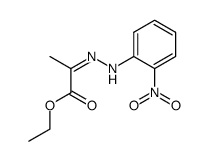
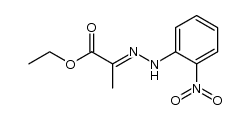
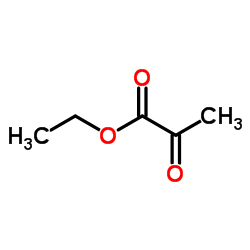

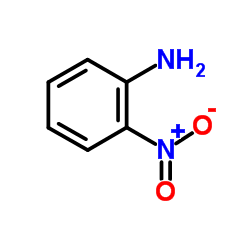
 CAS#:6960-45-8
CAS#:6960-45-8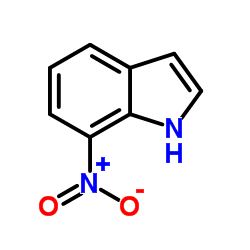 CAS#:6960-42-5
CAS#:6960-42-5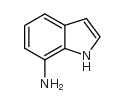 CAS#:5192-04-1
CAS#:5192-04-1
